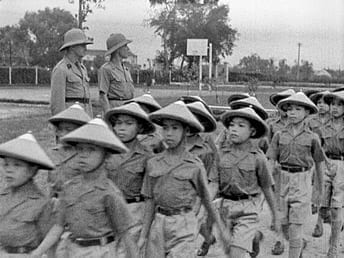
About three years ago, I was invited to speak at a round table at a Rithy Panh retrospective in São Paulo. The fact that the conference took place right after the screening of Panh’s 2003 masterpiece, S-21: the Khmer Rouge Killing Machine, made me focus less on the formal similarities his films shared with Chris Marker and other canonic film-essayists, and more on another, perhaps less orthodox parallel, which held me by the gut during that projection: Quentin Tarantino’s Inglorious Basterds (2009), more precisely Aldo Raine’s (Brad Pitt) final monologue before slitting a swastika in Col. Hans Landa’s (Christophe Waltz) forehead – “But you take off that uniform, ain’t no one ever gonna know you were a Nazi. And that don’t sit well with us. So, I’m gonna give you a little something you can’t take off.” Panh’s film is by no means a revenge and his direct approach has very little to do with Tarantino’s theatrics, but it shares a similar discomfort with how history is conveniently shaken off to allow former criminals to walk around as regular civilians, carrying no trace of their perverse past. Not unlike Aldo Raine, S-21 reaffirms the moral duty of portraying past official murderers as murderers, until the last day of their lives, carrying their proverbial caskets with them for the world to see.
Interestingly enough, La France…, a very different film, also recalls Inglorious Basterds, but for a very different reason: while cinema was often used as propaganda for historical perversities, it is cinema, too, that now allows some sort of redemption – or, in Tarantino’s case, revenge. Presented as part of MoMA’s Documentary Fortnight, Rithy Pahn’s latest film is a found footage tour de force made for French public television. With the exception of the prologue and epilogue, which bookend the film, La France… consists of newsreels, travelogues and other types of stock material that the filmmaker reedits and repurposes as an essay film about french colonialism in Southeast Asia, adding music and title cards (some of them clearly written for the film, while others, even if indeed written for the film, could easily pass as part of the original colonialist propaganda). In Rithy Panh’s most conceptual film to date, a simple displacement transforms images of colonialist propaganda into documents of oppression and, eventually, forms of resistance.
The filmmaker is very much aware of the paradoxical nature of this gesture, and the fact that it was made for French television only heightens this central contradiction. The soundtrack borrows equally from jazz, classical music and southeast asian indigenous folk music, establishing that the power of the film lies in adding “and vice-versa” to the end of every action. The road of irony is only a fruitful path when it goes both ways, and the film carries that awareness already in its title.
As often is the case with Rithy Panh’s films, there are moments in which the filmmaker goes out of his way to make sure the fairness of the gesture resonates, resorting to cinematic operations that are far too revealing of its desired effect to achieve them at all. The dialectic montage of a dog being trained and a native citizen being told to walk toward the camera by a foreigner, or the juxtaposition of the forced nudity of a native woman and the French vedette shyly covering her breasts from the camera are two all too clear examples of a kind of counter-propagandist approach that diminishes the terror of history as it were, and that Rithy Panh only rarely gives in to. Most of the time, reality takes care of retelling itself: footage of plant grafting can go from being an advertisement of agricultural techniques to a powerful metaphor by the mere change in context provided by the filmmaker. La France… is a much stronger piece when it trusts the strength of its basic, overarching concept (which is the case most of the time): to make a movie about cultural appropriation that relies solely on appropriation, repurposing the camera not as a window to the world, but as mirror of itself.
* Seen on DCP at MoMA’s Theater 1, as part of Documentary Fortnight 2016.






Leave a Reply